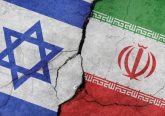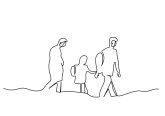1. The View from Tur Abdin
Recently I had a chance to visit the Christian community of Tur Abdin in Eastern Turkey, a long standing community. The monasteries where I stayed dated to the 5th century AD. The people are generous and welcoming, but there is certainly a feeling of isolation and anger in the community as well. You can see Syria stretching out in the distance from the Mor Hananyo Monastery. The people have family and friends in Syria and Iraq. These are the Christians who have been subjected to the brutality of the Islamic State (IS) along with the Yazidi, Shabak and Shia people of the region. Yet, this is nothing new to the people of Tur Abdin.
The monasteries, with their austere beauty and clockwork way of life, give the impression of tranquility. The reality is that this region of the world has been subjected to repeated instances of inter-ethnic and inter-religious conflict. All but one of the people I spoke about the region and its history had lost family in the pogroms of the late 19th century, the terrible bloodletting that accompanied the collapse of the Ottoman Empire, down to the recent conflict between Ankara and the Kurds. Violence is woven into the historical fabric of life in Tur Abdin.
The people are horrified and scared of what is happened a few kilometers from their homes, but they do not expect anyone to help. They’ve seen this before. The international community condemns, prevaricates and retreats. Admittedly, things are starting to happen. Airstrikes against IS have escalated and now include strikes in Syrian territory. Greater assistance is being given to the Kurdish Peshmerga, moderate Syrian forces and the Iraqis. However, this is insufficient. The world needs to decisively intervene in this conflict because the Islamic State is attempting to commit genocide against the minorities in their territory and we all have an obligation to stop them.
2. Genocide: A working definition
This is a big claim. We hear a lot about violence and possibly ethnic cleansing, but the term ‘genocide’ has not taken root in this debate. In its special session on Iraq, several members and observers of the United Nations Human Rights Council voiced concerns that IS was committing genocide.[i] Ed Husian, writing for the Tony Blair Faith Foundation, has also labelled the actions of IS as genocide.[ii] Yet, the dominant narrative is the standard post-9/11 justification of fighting the terrorists abroad before we have to fight them at home. This is tarnished by the legacy of the War on Terror and masks the need to intervene for the sake of the people being persecuted by IS.
The problem with genocide is that it is rather difficult to pin down. Surprisingly, there is relatively little conceptual work done on crimes against humanity and genocide to pinpoint what they are and what makes them particularly abominable. Genocide has been called the ‘crime of crimes’ and there is a hesitancy to use it in case it becomes debased by overuse.[iii] This was Bernard Lewis’ reason for claiming that the violence against Armenians during the collapse of Ottoman rule was not genocide.[iv] Yet, I believe it fits: to call something a genocide does not debase past genocides anymore than one murder diminishes another.
I’m going to take the most common definition. The one found in international law. Why? Because there are currently 146 parties to the Genocide Convention, including Iraq and Syria. It can provide a framework to condemn the Islamic State and trigger international responsibilities to prevent further atrocities and bring justice to those responsible.
Genocide as a crime has two basic components: the mens rea and the actus reus, which in ordinary language is the mental and physical components of the crime.
Regarding the mens rea, there needs to be ‘genocidal intent’. The acts of a person or group must be committed with the intention to destroy, ‘in whole or in part’ a ‘national, ethnical, racial, or religious group’.[v] There can be no such thing as an accidental genocide. Showing that there is intent is the largest hurdle for an accusation of genocide.
The actus reus is clearer cut. Genocide constitutes acts such as:
- Killing members of the group;
- Causing serious bodily or mental harm to members of the group;
- Deliberately inflicting on the group conditions of life calculated to bring about its physical destruction in whole or in part;
- Imposing measures intended to prevent births within the group;
- Forcibly transferring children of the group to another group. [vi]
The one thing that I will have you bear in mind here is that numbers do not matter as much as people think. When we think of genocide we think of numbers in the hundreds of thousands, like Rwanda or the millions murdered during the Holocaust. However, nothing in the Genocide Convention requires that there are hundreds of thousands of victims. Indeed, it is theoretically possible to have a silent genocide where a people is destroyed by preventing births and forcibly transferring children to other groups. This is not what is occurring in Iraq and Syria, but it should give us pause when thinking about what is and is not genocide.
3. The Islamic State: Actus reus
It seems evident to me that IS has committed at least four of the acts listed in the Genocide Convention. The most obvious is the massacre members of the Yazidi, Christian, Shabak and Shia communities in occupied territory.
At the time of writing there are reports of the execution of 500 Yazidi in Sinjar.[vii] Amnesty International has also reported mass killings in the Sinjar Region, specifically in the villages of Kocho, Qiniyeh and Jdali. The true death toll is pure speculation at this point, but it is most likely in the hundreds.[viii] The problem right now is that we have little idea of what is happening in IS controlled territory. These massacres may be isolated — or the tip of the iceberg. However, given that these massacres prompted roughly 250,000 people from minority communities to flee IS territory since June, I suspect that these are not trivial or incidental.[ix]
This leads to the second act: deliberately hurting conditions of life calculated to bring about the destruction of a community. As mentioned, hundreds of thousands of people have fled northern Iraq since June. Many have found shelter in the south, in Kurdish controlled areas, and in refugee camps in the region. However, as many as 50,000 were driven into the Sinjar Mountains, including many children. These mountains are far from hospitable. If it were not for humanitarian assistance from the United States and Kurdish Peshmerga, many of these people would have died, either from exposure or dehydration if they stayed on the mountain, or at the hands of IS militants if they ventured down.
Finally, there are the categories of serious bodily and mental harm, along with the removing of children. During this refugee crisis there have been multiple reports of mass abduction and rape of women and children. According to reports, some 1,500 Yazidi, Christian, and Shabak women and children have been abducted by the Islamic state. The fate of these abductees is hard to determine. There are reports of rape, slavery, coerced marriage and forcible conversion to Islam.[x]
4. The Islamic State: Mens rea
It is evident that ISIS is committing serious crimes in Northern Iraq and Syria, but is this not enough on its own to make the case for genocide? Is there genocidal intent among the IS leadership? Commonly we think of genocidal intent as a systemic plan to exterminate a group of people, as was the case with the Holocaust. There are good reasons to think that the purging of minorities in Northern Iraq is the product of such a plan.
The leaders of the Islamic State, like Abu Bakr al-Baghdadi, have made the aims of the Islamic State very clear. They wish to construct a radical Salafist Muslim state. There is limited toleration for ahl al-kitab (‘people of the book’, like Jews and Christians) in this account. Hence Christians being offered the choice to convert, pay, flee, or die, while the Yazidi are offered the choice of convert, flee or die. Their particular interpretation of Islam places Yazidi outside the “Dhimmi pact” in the words of Ed Husain.[xi] Christians have been told they can pay the jizyah, a tax on non-Muslims, but by most accounts it is beyond the means of most people. The Yazidi do not even have this option. They are mushrikun, or people who do not worship God. They are not afforded the limited rights owed to jizyah paying ahl al-kitab. This makes them subject to convert or die demands with the emphasis on the latter given that the Yazidi are considered devil worshippers by IS. In the announcement of the ‘caliphate’, al-Baghdadi repeatedly speaks of his desire to forge a radical Islamic state in which non-Muslims and non-Sunnis have been cleansed or are in deeply subordinate positions. He repeatedly uses the term kafir to refer to non-Muslims, which is extremely derogatory. It is a sign of domination and dehumanisation.[xii] Additionally, a YouTube clip of a military commander in Sinjar during the crisis said that those refugees on Sinjar who do not want to convert can die of thirst on the mountain.[xiii] This is far from an open and close case, but the speeches from IS commanders and political leaders have a similar tone to those found in the Nazi regime, Khmer Rouge and the Hutu Government in Rwanda. It is a twisted form of utopianism whereby society is perfected by the destruction of impure elements. What is missing is a smoking gun. There is no statement from al-Baghdadi saying ‘I’m going to commit genocide’. Yet this almost never happens: even in instances like the Holocaust, the mens rea is established through public and private statements, government documents and internal memoranda.[xiv] However, there is enough here to suspect genocidal intent. There seems to be a coordinated effort by IS to purge its territory of those who do not match its idea of an Islamic state, rather than mere indiscriminate violence.
5. Justice
You might not be convinced that this is genocide. The numbers of deaths are low when compared to the Holocaust or the Rwandan Genocide. However, the fact that hundreds of thousands have not died is irrelevant. The Convention allows for prosecution for the ‘conspiracy to commit genocide, incitement to commit genocide, and the attempt to commit genocide’.[xv] The actions of IS during the Siege of Mount Sinjar shows intent to commit genocide by inflicting conditions of life calculated to destroy the entire communities. It does not matter that this happened to portion of these communities since genocide can apply to a part or a whole of an ethnic or religious community. There is a strong case to be made that the IS has been attempting to commit genocide against those who do not meet their definition of religious purity. This should be enough to warrant intervention.
So far we have treated IS as hostis humani generis. Placing them in the same category as pirates and outlaws, enemies of humanity that can be summarily killed. This is not justice. Indeed, it runs the risk of making martyrs out of monsters. The leaders of IS such as Abu Bakr al-Baghdadi and his lieutenants should not be killed and certainly should not be spirited away to some black site never to be seen again. They need to be tried in open court. Their crimes against Christians, Yazidis and Muslims need to be laid bare for the world to see. This would show communities like the Christians of Tur Abdin that they are not alone. It might also help to break the spell that IS has cast over disenchanted Muslims in the West, just as the Nuremberg Trails revealed the depths of Nazi depravity.
Humanitarian intervention has a bruised reputation these days. In no small part this is because there never seems to be a concrete plan of what happens after intervention. The trail of IS leaders needs to be a part of any post-intervention strategy. It would provide a chance to show the embattled minorities of the region that they are not alone.
[i]Office of the High Commissioner for Human Rights. Human Rights Council opens Special Session on the Human Rights situation in Iraq. 1 September 2014.
[ii]Ed Hussian. How ISIS Justifies Genocide. Tony Blair Faith Foundation. 11 August 2014.
[iii]Larry May. Genocide: A Normative Account. Cambridge: Cambridge University Press, 2010: p. 6
[iv] Dalia Karpel. “There Was No Genocide: Interview with Prof.Bernard Lewis”. Ha’aretz Weekly. January 23, 1998. http://www.ataa.org/reference/karpel.html
[v] UN General Assembly, Prevention and punishment of the crime of genocide, 9 December 1948, A/RES/260
[vi] UN General Assembly, Prevention and punishment of the crime of genocide, 9 December 1948, A/RES/260
[vii]Adama Dieng and Jennifer Welsh, Statement by Adama Dieng, Special Adviser of the Secretary-General on the Prevention of Genocide, and Jennifer Welsh, Special Adviser of the Secretary-General on the Responsibility to Protect, on the situation in Iraq. 12 August 2014.
[viii]Amnesty International. Ethnic Cleansing on a Historic Scale: Islamic State’s Systematic Targeting of Minorities in Northern Iraq. London: Amnesty International, International Secretariat, 2014: pp. 8-16
[ix]Office of the High Commissioner for Human Rights. Human Rights Council opens Special Session on the Human Rights situation in Iraq. 1 September 2014.
[x]Amnesty International. Ethnic Cleansing on a Historic Scale: Islamic State’s Systematic Targeting of Minorities in Northern Iraq. London: Amnesty International, International Secretariat, 2014:pp. 17-23
[xi]Ed Hussian. How ISIS Justifies Genocide. Tony Blair Faith Foundation. 11 August 2014.
[xii]SITE Institute. ISIS Spokesman Declares Caliphate, Rebrands Group as “Islamic State”. 29 June 2014.
[xiii]Amnesty International. Ethnic Cleansing on a Historic Scale: Islamic State’s Systematic Targeting of Minorities in Northern Iraq. London: Amnesty International, International Secretariat, 2014: p. 4
[xiv] Geoffery Robertson, Was there an Armenian Genocide? London: Armenian Centre, 2009: p. 24
[xv] UN General Assembly, Prevention and punishment of the crime of genocide, 9 December 1948, A/RES/260








No Comment